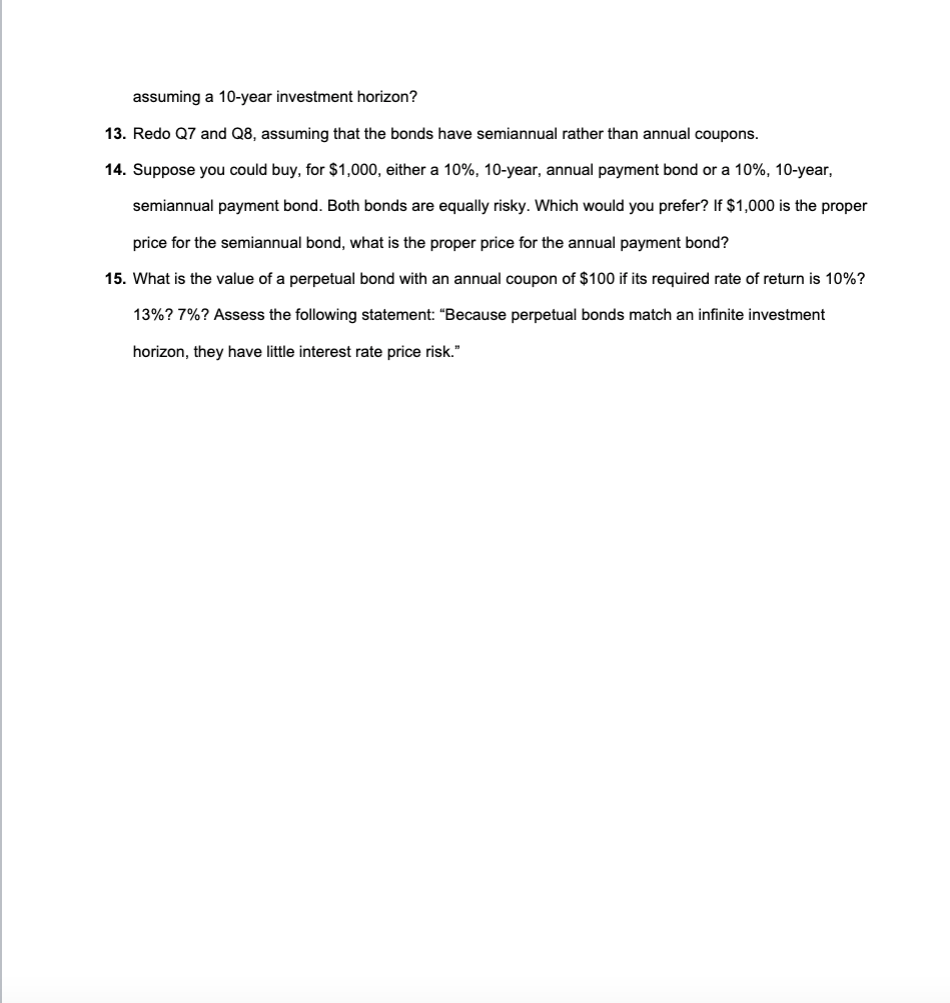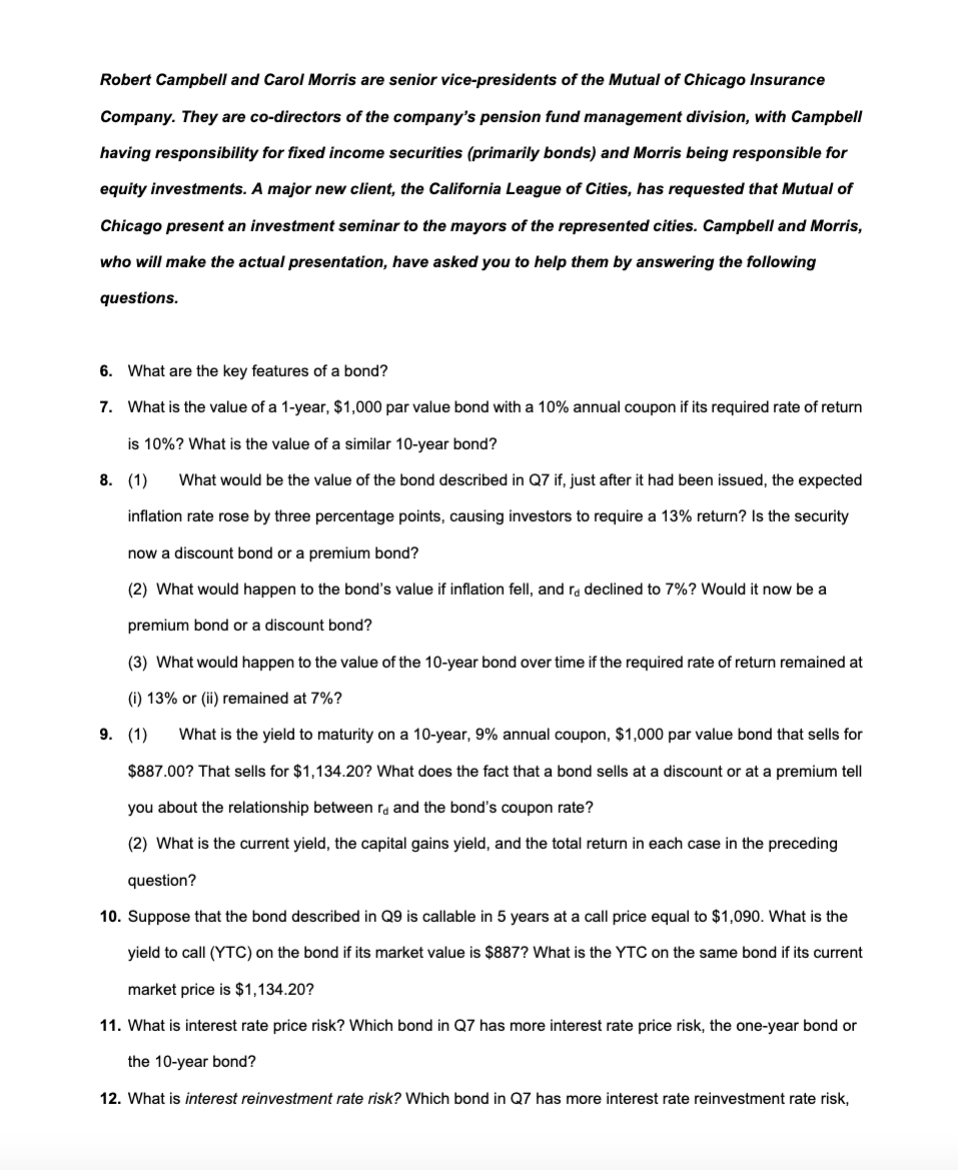assuming a 10-year investment horizon? 13. Redo Q7 and Q8, assuming that the bonds have semiannual rather than annual coupons. 14. Suppose you could buy, for $1,000, either a 10%, 10-year, annual payment bond or a 10%, 10-year, semiannual payment bond. Both bonds are equally risky. Which would you prefer? If $1,000 is the proper price for the semiannual bond, what is the proper price for the annual payment bond?
assuming a 10-year investment horizon? 13. Redo Q7 and Q8, assuming that the bonds have semiannual rather than annual coupons. 14. Suppose you could buy, for $1,000, either a 10%, 10-year, annual payment bond or a 10%, 10-year, semiannual payment bond. Both bonds are equally risky. Which would you prefer? If $1,000 is the proper price for the semiannual bond, what is the proper price for the annual payment bond?
Chapter9: Responsibility Accounting And Decentralization
Section: Chapter Questions
Problem 1TP: You have just been elected president of a brand-new service club on campus. The club is part of a...
Related questions
Question
please give answer for 13,14, and 15

Transcribed Image Text:assuming a 10-year investment horizon?
13. Redo Q7 and Q8, assuming that the bonds have semiannual rather than annual coupons.
14. Suppose you could buy, for $1,000, either a 10%, 10-year, annual payment bond or a 10%, 10-year,
semiannual payment bond. Both bonds are equally risky. Which would you prefer? If $1,000 is the proper
price for the semiannual bond, what is the proper price for the annual payment bond?
15. What is the value of a perpetual bond with an annual coupon of $100 if its required rate of return is 10%?
13%? 7%? Assess the following statement: "Because perpetual bonds match an infinite investment
horizon, they have little interest rate price risk."

Transcribed Image Text:Robert Campbell and Carol Morris are senior vice-presidents of the Mutual of Chicago Insurance
Company. They are co-directors of the company's pension fund management division, with Campbell
having responsibility for fixed income securities (primarily bonds) and Morris being responsible for
equity investments. A major new client, the California League of Cities, has requested that Mutual of
Chicago present an investment seminar to the mayors of the represented cities. Campbell and Morris,
who will make the actual presentation, have asked you to help them by answering the following
questions.
6. What are the key features of a bond?
7.
What is the value of a 1-year, $1,000 par value bond with a 10% annual coupon if its required rate of return
is 10%? What is the value of a similar 10-year bond?
8. (1)
What would be the value of the bond described in Q7 if, just after it had been issued, the expected
inflation rate rose by three percentage points, causing investors to require a 13% return? Is the security
now a discount bond or a premium bond?
(2) What would happen to the bond's value if inflation fell, and re declined to 7%? Would it now be a
premium bond or a discount bond?
(3) What would happen to the value of the 10-year bond over time if the required rate of return remained at
(i) 13% or (ii) remained at 7%?
9. (1) What is the yield to maturity on a 10-year, 9% annual coupon, $1,000 par value bond that sells for
$887.00? That sells for $1,134.20? What does the fact that a bond sells at a discount or at a premium tell
you about the relationship between ra and the bond's coupon rate?
(2) What is the current yield, the capital gains yield, and the total return in each case in the preceding
question?
10. Suppose that the bond described in Q9 is callable in 5 years at a call price equal to $1,090. What is the
yield to call (YTC) on the bond if its market value is $887? What is the YTC on the same bond if its current
market price is $1,134.20?
11. What is interest rate price risk? Which bond in Q7 has more interest rate price risk, the one-year bond or
the 10-year bond?
12. What is interest reinvestment rate risk? Which bond in Q7 has more interest rate reinvestment rate risk,
Expert Solution
This question has been solved!
Explore an expertly crafted, step-by-step solution for a thorough understanding of key concepts.
This is a popular solution!
Trending now
This is a popular solution!
Step by step
Solved in 3 steps

Knowledge Booster
Learn more about
Need a deep-dive on the concept behind this application? Look no further. Learn more about this topic, finance and related others by exploring similar questions and additional content below.Recommended textbooks for you

Principles of Accounting Volume 2
Accounting
ISBN:
9781947172609
Author:
OpenStax
Publisher:
OpenStax College



Principles of Accounting Volume 2
Accounting
ISBN:
9781947172609
Author:
OpenStax
Publisher:
OpenStax College




Cornerstones of Cost Management (Cornerstones Ser…
Accounting
ISBN:
9781305970663
Author:
Don R. Hansen, Maryanne M. Mowen
Publisher:
Cengage Learning
